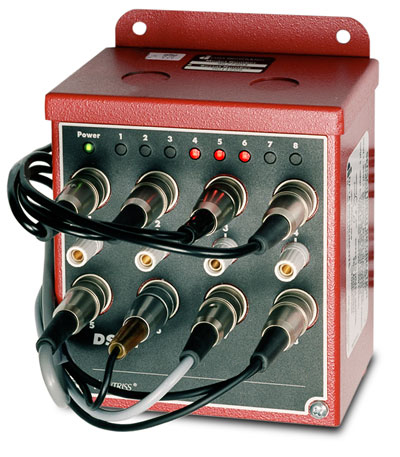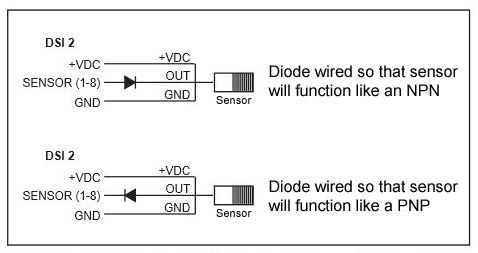100 Discovery Way, Unit 110, Acton, MA 01720 US.
Mon-Fri, 8:00 AM - 5:00 PM (GMT-5)
Electronic Sensor Outputs and Wiring
Electronic sensors for die protection are usually either 3-wire or 4-wire DC sensors. Three wire sensors have either a normally open or normally closed output; four wire sensors have complementary outputs (both a normally open and a normally closed output). The wires are typically color-coded. The wiring connections are show in the table below.
| 3 & 4-Wire DC Sensor Connections | |
|
|
The brown wire is connected to the positive side of the DC power supply, the blue wire is connected to the common (or minus side) of the DC power supply, and the black and/or white wires are connected to the die protection control or sensor interface. If a sensor has both black and white output wires, these are usually complementary - one will operate as normally open (ON when the sensor is actuated, OFF when it is not) and the other as normally closed (OFF when the sensor is actuated, ON when it is not).
NPN and PNP Outputs
When a sensor actuates (or turns ON), the output will will be driven to a voltage level - either
high or low. "High" is equal to the sensor's supply voltage (usually 24 volts DC).
"Low" is a much lower voltage, usually from .75 to 3.5 volts DC. Whether sensor "goes" high or
low is determined by the sensor's output type. The output of a PNP sensor goes High, the
output of an NPN sensor goes Low. A PNP output is sometimes called a 'sourcing' or 'open
emitter' output, while NPN is sometimes referred to as 'sinking' or 'open collector'.
When either type of sensor (NPN or PNP) is OFF (not actuated) the outputs do not switch to the opposite voltage level; instead they simply turn off or 'open up', as if somebody simply unplugged the wire. A sensor in its OFF state is neither 'High" nor "Low".
Push/Pull Sensor Outputs
While PNP and NPN sensors' outputs are open when not actuated, there is another type of
sensor output called a 'Push/Pull' output that is actively driven either high or low depending on
whether the sensor is detecting its target object or not. The output of such a sensor acts a
PNP when actuated and as an NPN output when the sensor is not actuated (or vice-versa).
With a Push/Pull output, there is always current flow from the sensor in one direction or the other
regardless of its condition.
Sensor Interfaces and Sensor Inputs
The first die protection sensor interfaces included a power supply for the sensors, as well as
sensor inputs that ultimately connected to the die protection control. These inputs of the
early sensor interfaces were designed to turn ON when the input detected a particular voltage level
(either high or low). As a result, they would work with either NPN or PNP sensors,
but not both. If you had one of these, you had to ensure that any sensors you selected met
the input requirements of the interface - either NPN or PNP.
Since the outputs of NPN and PNP sensors are virtually open (with no voltage output) in the off condition, a voltage-sensing interface requires internal circuitry to direct the input voltage in the opposite direction of the sensor's output so that it could detect when the sensor is off. This was accomplished by using a simple electronic component called a resistor. For an NPN input type, the resistor is connected internally from the sensor input to the supply voltage. This is called a 'pull-up' resistor. For an NPN input type, the resistor is connected internally to ground and is referred as a pull-down' resistor.
When an NPN or PNP sensor actuates, its output easily overcomes the small amount of current flowing through the pull-up or pull-down resistor and drives the input to the appropriate voltage level. A simple non-electrical analogy for a pull-up/pull-down resistor is the spring inside a spring-loaded scale: When a load is placed on the scale, the scale's needle will point to its weight. When the weight is removed, the spring inside the scale returns the needle to zero. The 'load' on the scale is analogous to the sensor actuation, the spring inside the scale is the pull-up/pull-down resistor.
If a push/pull output sensor is used with a voltage sensing interface, the pull-up/down resistor is not necessary, but its presence does not negatively affect the operation of the sensor.
Current Sensing Sensor Interfaces
There is a problem with voltage sensing interfaces: They will work with either NPN or PNP sensors,
but not both. This limitation is a hindrance when you are running dies from multiple sources.
Some dies may be equipped with PNP sensors, others may have NPN, and you need the ability to run
either (or a mixture of both).

The Wintriss Die Protection Interface (DSI2) can accept input from both NPN and PNP sensors
As a result, modern sensor interfaces such as the Wintriss DSI-2 have been designed to sense current flow - either positive-going (PNP) or negative-going (NPN) without having to change anything. A modern current-sensing interface can accept input from PNP or NPN sensors interchangeably because instead of looking for a particular voltage level, these interfaces are designed to detect the current flow that occurs when a sensor is actuated, and the sensor output is driven either high or low.
An additional component is required when using push/pull output sensors with a current-sensing interface. Since the output of a push/pull sensor is driven in one direction or the other regardless of whether the sensor is on or off, it will always look ON (actuated) to a current- sensing interface.

Push-Pull Sensor Wiring Showing Diode in Series
To allow push/pull sensors to properly function with current-sensing interfaces, a diode must be placed in between the sensor output and the input of the interface. A diode acts as a 'one-way valve' for current flow. It will allow current flow in one direction but not the other. When a diode is placed in series with a push/pull sensor's output, it will block the current flow to the sensor interface when the sensor is not actuated, allowing it to function as either an NPN or PNP depending on the direction in which the diode is installed (see the diagram above for push-pull sensor wiring to the Wintriss DSI-2).
© Copyright 2021 Wintriss Controls Group LLC - All Rights Reserved